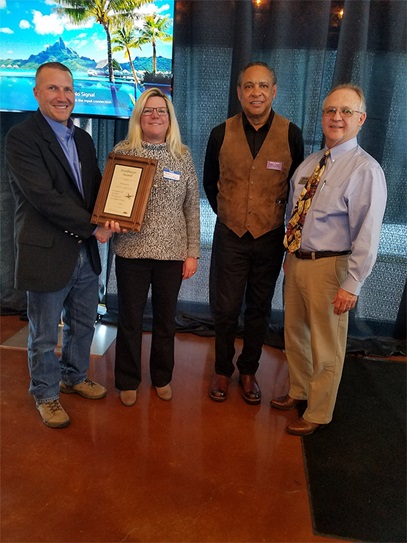
Patti Arthur has practiced law for about 30 years and represents clients nationwide. As a former airline pilot and airline instructor, she is now the practice manager for UAV (Drone), Aviation and Tax Law for Anderson & Hughes, P.C. in Colorado. She earned her LL.M. in Taxation from the University of Denver in 1991. Ms. Arthur also has extensive experience representing aviation businesses, airports, flight schools, hangar owners and developers, Fixed Based Operators, charter operators, corporate flight departments and individual pilots, including airline crew members, with regulatory compliance issues. To the left, she is receiving the "Trailblazer" award from her county's Economic Development Corporation for her work in drone business development in rural parts of the county.
For-profit or nonprofit? Partnership or limited liability company? Tax-exempt 501(c)(3) or 501(c)(7)?
Basic business entity selection is made at the state level. When the club is established it will file organizing documents with the state agency or department overseeing business organizations in the club’s state.
The FAA defines a flying club as a nonprofit or not-for-profit entity. So, to be a true "flying club" in the eyes of the FAA, the business entity should be organized as a nonprofit or not-for-profit entity at the state level.
When filing business formation documents at the state level, the choice for nonprofits then becomes whether to form as a nonprofit corporation or a nonprofit LLC. The LLC is not a preferred method for organizing a nonprofit entity because the individual state laws for LLCs don’t mesh very well with the federal laws covering tax-exempt organizations. It can be done, but it’s complicated and requires the advice of an experienced tax professional, which can be costly. The preferred and much easier avenue is to organize the club as a nonprofit corporation at the state level.
Clubs may also wish to avoid the burden of paying income tax on revenue over expenses, and also want to allow for the tax-exempt collection of surplus funds for ongoing maintenance or cash reserves set aside for future maintenance requirements. This tax-exemption is applied for at the federal level. Simply filing as a nonprofit corporation at the state level does not automatically qualify the club as exempt from tax at the federal level.
Sometimes a question arises as to whether a nonprofit flying club can qualify for a tax exemption as a 501(c)(3) public charity. Theoretically, this is possible and there are some individuals who promote this classification by stating the club is being operated as an educational organization. However, in reality this is not the case for most clubs. Additionally, IRS requires the assets of 501(c)(3) organizations to be distributed to another 501(c)(3) or a governmental entity upon dissolution. It would not allow distribution of assets to members who have invested in the club.
The correct and preferred federal tax-exempt classification for flying clubs is the 501(c)(7). 501(c)(7)’s are tax-exempt social or recreational clubs like tennis clubs or boating clubs. This exemption is applied for using IRS Application 1024 and is well-suited for flying clubs. 501(c)(7)s are exempt from federal taxes, but member dues are not deductible. There are also restrictions on allowing aircraft rental to non-members of the club and the club must demonstrate that it regularly has social and recreational activities for club members, which includes the recreational activity of renting club aircraft for pleasure flying. The current filing fee for Application 1024 is $600. The application is not inherently difficult, but it is recommended to seek the advice and/or review of a CPA or lawyer who has handled Form 1024 applications in the past.
As a bottom line, if club organizers wish to establish a nonprofit flying club, filing as a nonprofit corporation at the state level and then filing IRS Application 1024 to request recognition as a tax-exempt 501(c)(7) social or recreational club is the preferred way to go.






